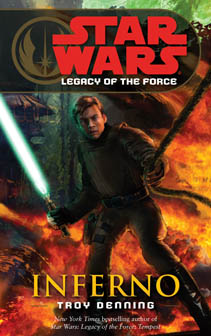“Inferno” (2007), the sixth book of the nine-book “Legacy of the Force” series, is the one where Jacen begins referring to himself as Darth Caedus in the scenes told from his perspective. It’s an appropriate time for that transition, because the new Dark Lord of the Sith significantly adds to his evil tally here – tricking Ben into killing former Chief of State Omas, threatening the Jedi Academy at Ossus, and burning the trees and cities of Kashyyyk to the ground.
An unusually tight 289-page offering from Troy Denning, “Inferno” is an enjoyable enough read, but sometimes it skirts the edge of parody. The storyline, which saw Jacen kill Mara in the previous book, has gotten so grim that I almost laughed out loud during a rather clichéd sequence where Leia goes still with a feeling in the Force and Han assumes Jaina is dead. (As it turns out, Luke is “dead.” But of course he was just faking his death in the Force; I bet this fooled exactly zero readers.)
Now that Jacen is definitively Darth Caedus, it seems like a good time to reflect on how his path has mirrored that of Darths Sidious and Vader. Jacen’s original conceit was that he would succeed in creating a stable and peaceful galaxy where his Sith predecessors failed because 1) he does not desire power for personal gain, like Sidious did, and 2) he is willing to sacrifice his emotional attachments, whereas Vader wasn’t.
Caedus has followed those tenets so far. He has near-Palpatine-level power: He is the co-chief of state, along with Admiral Niathal, without having won an election, and – utilizing a loophole — he has the ability to write some laws. The fact that he has “good” intentions rather than “evil” intentions seems moot from an outsiders’ perspective. His actions are still evil, and they still inspire rebellion and instability, so it seems like his “goodness” matters mostly to Jacen himself.
And he has been willing to sacrifice attachments. Just as Jacen is dead to Han, Leia and Jaina at this point (a conclusion they come to largely off-page, which is an odd choice by Denning, because these could’ve been engaging, emotional discussions), Jacen has long since decided that his family is dead to him since they don’t fall in step with his imperial vision for the Alliance (indeed, he literally did kill his aunt in the last book). Previously, Caedus had set aside Tenel Ka and Allana as exceptions, but on page 277, after Tenel Ka takes up arms against him in the Kashyyyk space battle, he adds her to the list. Although it hurts, “he (knows) the sacrifice (will) strengthen him eventually.” Still, Allana could be the line he’s not willing to cross, just as Vader wasn’t willing to sacrifice Luke.
Caedus, though, has more in common with Sidious than Vader. He kills Mara just as Sidious kills Padme. And just as Sidious lies to Vader about who is responsible for Padme’s death (he blames Vader himself), Caedus lies to Ben about who is responsible for Mara’s death – first framing Omas and later letting the fact that Alema was near the scene of the murder create reasonable doubt.

Caedus has the same problem as Sidious: He needs a reliable apprentice if his new galactic order is to last beyond one generation. (Alternatively, he could learn the Sith art of eternal life, something that Darths Bane, Plagueis and Sidious — and later, Krayt — achieved to varying degrees, but “Legacy of the Force” doesn’t take this path, perhaps wanting to avoid redundancy.) As noted above, Caedus “good intentions” don’t distinguish him from Sidious in any externally meaningful way, so if his empire is to succeed where Sidious’ failed, he needs an apprentice who shares his vision. Ben already hates Jacen’s guts and finally sees the flaws in the vision of “peaceful order” in “Inferno,” Alema is psychologically unstable and Tahiri is only letting Caedus use her so she can flow-walk into the past and see Anakin again. (In another almost parodic scene, Tahiri tries and fails to arrest Han and Leia on Jacen’s orders here, just as Ben did earlier in the saga.)
Interestingly, Alema visits the Sith cult on Korriban and they tell her they have no interest in what Jacen is doing. Apparently, the preeminent dark-side planet is not going to be a wellspring of apprentices, either. So Caedus has a serious long-term problem. And underlying all of this is the strong possibility that a “stable, peaceful galaxy” is a contradiction in terms to begin with.
On page 273, Caedus notes that the Coruscanti public still loves him, and the crew of his flagship is in awe of him and “would follow him into the Core itself.” But in a meeting between various anti-Jacen factions, Han suggests on page 288 an obvious but brilliant arrangement between the Confederation and the anti-Jacen forces within the Alliance: “Why don’t we just, uh, sort of ignore each other for a while?” An agreement is forged: Both sides will try their own methods to take out Jacen, and after that is accomplished, perhaps they can engage in rational peace talks (something that was tried back in the first book before Lumiya intervened, effectively launching Jacen’s villain’s journey).
Six books in, Jacen has already spectacularly failed to bring the galaxy together. He has continued to fan the flames of the war (literally, in the case of Kashyyyk) and has made it so the bulk of the militaries and the citizens of the galaxy oppose him. He has his flagship crew and the Coruscanti public nominally on his side, but he’ll likely lose a bunch of those people when word of his actions at Kashyyyk get out. He lacks a solid apprentice. And what’s worse for him, whereas Sidious and Vader had one novice Jedi to worry about, Caedus will have to contend with a bevy of masters, including one (Luke) who is demonstrably more powerful than Caedus is (Luke fails to kill Caedus in “Inferno” only because Ben distracts him.).
Caedus – because he never successfully tricked enough people – has skipped over the period of a stable imperial reign (Sidious got in a good quarter-century on the throne) and cut right to the point where he has fomented a powerful rebellion. Rather than being at a point equivalent to “Revenge of the Sith,” he’s already at a point equivalent to the beginning of “Return of the Jedi.”

